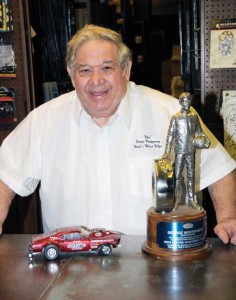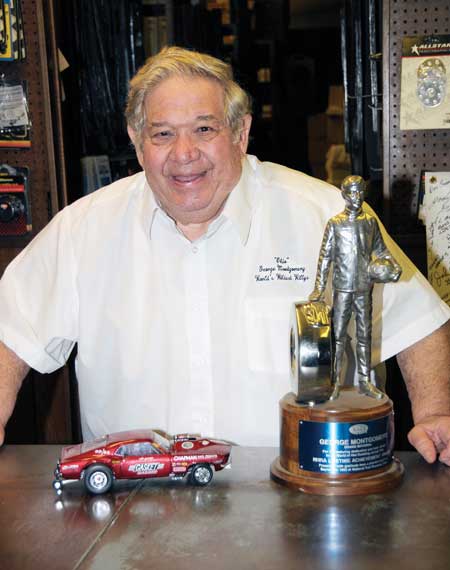
His business card provides the data on “George’s Speed Shop Precision Racing Engines,” but doesn’t provide much of a clue of who George is or what he does. You might be surprised to learn that the George in this case is better known as “Ohio George” Montgomery, a legendary NHRA national driver.
But if you have any memory of drag racing’s golden years of the 1960s, you likely already know a lot about this performance pioneer’s storied career.
The racing career started in 1955 when he put a ’59 Caddy engine in a ’34 Ford Coupe and competed competitively in the Top Eliminator Class in NHRA regional events. Then, in 1958, he bought a ’33 Willys for $100 and equipped it with a Caddy engine. Competition began in 1959 and he had a number of NHRA class wins through the 1961 season, including the Nationals Little Eliminator Class in both 1959 and 1960.
The winning continued in 1963 with a blown small block Chevy under the hood of the Willys Gasser for the new A/GS Blown class. In 1963, he captured the class along with taking the Middle Eliminator Class at the 1963 NHRA Nationals.
Ford Corporate Relationships
New power was in place for the 1966 season as a result from an alliance George formed with the Ford Motor Company. It was the new 427 SOHC Ford engine, supercharged and injected and capable of 1,700 horses.The results with the new power were stunning as Montgomery took both the 1966 and ’67 Nationals in addition to the ’67 Winter Nationals.
But because Ford wanted a Ford body on its drag machines, it was decided that a new dragster would have a modern look. Montgomery added an all-fiberglass ’67 Mustang body, soon to be known as the “Malco Gasser.”
A multitude of national wins followed with Super Eliminator victories at the Spring Nationals in 1969 and Competition Eliminator wins at the Gator Nationals two times, in 1973 and 1974.
His on-track accomplishments made him a household name, often mentioned in the same breath as Don Garlits, Shirley Muldowny, Connie Kalitta, and the like.
After Racing
But there was much more to Montgomery than his driving capabilities. He was also involved with the repairing, tuning and maintaining those powerhouse engines he used during his national NHRA days. In addition, he was – and still is – a master builder of a multitude of racing engines covering just about all aspects of motorsports.
His success as an engine builder has been described with a number of adjectives, according to past and current customers, including innovative, persistent, smart, self-taught and flexible. No challenge was ever too complex to be addressed.
An articulate retainer of past work, his files indicate that there have been many thousands of engine projects. On numerous occasions, engine problems have been brought to George after failures from other companies. Even though Ford has been his main emphasis, he’ll work on any brand.
The old saying of “Let George do it!” certainly fits this guy to a T. Don’t believe it? Just look at the multitude of engine types he’s built, tuned, modified, tested and repaired over some five decades. Included are performance marine, NASCAR, ARCA, truck pulling, off-road truck racing, desert racing, IndyCar, Indy Lights, monster truck, sprint car and drag race (of course) engines.
When he retired from racing in the mid-1980s, his only son Gregg joined the scene, helping Dad at his modest Riverside, OH, facility. The apple didn’t fall far from the tree with Gregg who certainly inherited his father’s engine building skills.
The younger Montgomery explains, “I was in the shop when I was only five years old and doing useful jobs. By the time I was 17, I could operate all the machines in the shop.”
Today, he says, “Our specialty is blueprinting and dyno testing ’60s and ’70s classic and muscle car engines.”
The Shop
Stepping into the shop gives one the idea of stepping back into the 1950s and ’60s. The old-style parts counter is still in place with George there to greet you. There are large cases filled with George’s trophies, but what really gets your attention are the dozen or so NHRA national win “Wallys” that are sitting around. Also on display are popular diecast models of his famous drag machines.
The shop is filled with many engine-related machines including a pair of 1960s-vintage Heenan and Froude dynos. In addition there are cylinder, line and rod hones, a crank balancer, miscellaneous lathes and mills, ultrasonic cleaners and a magnetic particle inspection machine.
The shop performs a broad range of services, including head work, rod reconditioning machining and restoration, custom piston services, crankshaft grinding, engine balancing as well as short block and complete engine assembly and testing.
While there’s a combination of vintage and modern machines, all contributing to completion of the many tasks they perform, George says that he’s still most comfortable with the half-century-old equipment. “You have to operate these machines with your brain, while the modern stuff uses a computer. I guess you would have to call me an ‘old school’ guy.”
The Indy Lights Experience
During the 1980s and ’90s, the Indy Lights series (a feeder series to the IndyCar series) was established. Headed by Indy Car owner Pat Patrick, the series used spec Buick V6 engines for the series. Patrick turned to Montgomery to build, maintain, repair and tune the engines so that they would be within one horsepower of each other. At one time, there were 80 of the engines sitting in the historical shop.
“It was a monstrous job and pulled us away from our normal engine operations,” explains the younger Montgomery. “When the series faded away, it left us with many of the engines. But now, there are Indy Lights cars running in vintage racing and demand is picking up for the engines.”
Engine Building Philosophy
George Montgomery’s mind is still sharp as a tack as he explains the techniques he’s perfected over the years. From induction systems ranging from carburetion to injection to turbocharging to supercharging, he can get it done. Whether it’s small four-cylinder in-line engines to pounding big blocks, alcohol or fuel, high rpm range or a torque emphasis – no problem!
Through the years, he’s built his own superchargers, end plates, engine tranny adaptors, and numerous other parts and pieces as needed. He still remembers the vintage performance parts he used in the early years, with such brand names as Jahns Pistons, Howard and Isky Cams, Reath Cranks, Jocko Headers, Offy Intakes, Carter Carbs, and more. In fact, on the shelves are many vintage parts ready for use for a vintage build should it be requested.
This shouldn’t be a surprise, however. Montgomery is quick to remind visitors of a surprising fact about his shop. “You know that this is the oldest still-active speed shop in the nation,” he says. “It’s been in business since 1950 and many of the greats of drag racing and other types of motorsports have walked through the doors.”
Montgomery was even involved with Evel Knievel in preparing engines in his support vehicles during some of his jumps.
Ask him what his favorite engine over the years has been, and he quickly tells you that he likes the particular engine he is working on at the time. Two of the most interesting projects, though, involved Ford Boss 429 engines for the pulling and monster trucks of Diehl Wilson. “For the 4WD pulling truck,” explains Wilson, “George built me an injected Boss 429 engine that was bored and stroked to 529 cubic inches and made a ton of horsepower. For the monster truck (The Virginia Giant), it was a 672 Boss engine with a roots-style blower and worth 1,000+ horsepower.”
In other dirt applications during the early 2000s, the shop built upgraded Ford 351 Windsor carbed engines for the trucks in the Lucas Oil off-road racing ‘series. Even the fast sand caught his early interest as he modified a Ford flathead engine and raced a ’34 Ford. Later, he and Gregg prepared a Mercedes-Benz engine for a salt flat run.
The Customer Is Always Right – If He Can Afford It
Montgomery says certain realities have to be taken into consideration when he’s discussing a new engine build-up for a customer. “I don’t immediately start to think about how the engine should be built in order to accomplish the customer’s desired result, because the real question is cost,” he says.
“The first thing I always ask is ‘How big is your budget?’ That immediately defines a lot of the parameters of the engine. Rarely does somebody come in here with an unlimited checkbook.”
Of course, he’s not going to turn away a true performance enthusiast. “If he’s got the money, I certainly have the time to provide him what he needs,” Montgomery says.
And if tuning or modification is later required, you can bet that George and Gregg will be ready to assist. The follow-up service is part of their reputation through the decades that has given them their legendary status in the vintage racing market. 













